2012 MERCEDES-BENZ E-CLASS COUPE tyre pressure
[x] Cancel search: tyre pressurePage 347 of 389

R
Check the tyre for foreign objects.
R Chec kwhether the wheel is losing air or the
valve is leaking.
If you are unable to rectify the damage, con-
tact a qualified specialist workshop. H
Environmental note
Check the tyre pressure regularly, at least
every 14 days.
You will find a table of tyre pressures for var-
ious operating conditions on the inside of
your vehicle's fuel filler flap.
Operation with the emergency spare
wheel(Y page 363).
Operation with a trailer: the applicable
value for the rear tyres is the maximum tyre
pressure value stated in the table inside the
fuel filler flap.
The table inside the fuel filler flap may state
tyre pressures for different load conditions.
These are defined in the table as different
numbers of passengers and amounts of lug-
gage. The actual number of seats may vary;
for more information, please refer to the vehi-
cle's registration documents.
If tyre sizes are not specified, the tyre pres-
sures stated on the tyre pressure information
label apply for all tyres approved for this vehi-
cle. If a tyre size precedes a tyre pressure, the
following tyre pressure information is only
valid for that tyre size.
Use a suitable pressure gauge to check the
tyre pressure. The outer appearance of a tyre does not permit any reliable conclusion about
the tyre pressure.
If possible, only correct tyre pressures when
the tyres are cold.
The tyres are cold:
R
if the vehicle has been parked with the tyres
out of direct sunlight for at least three
hours and
R if the vehicle has not been driven further
than 1.6 km
Depending on the ambient temperature, the
speed at which you are driving and the load
on the tyres, the tyre temperature and thus
the tyre pressure change by approximately
10 kPa per 10 † (0.1 ba r/1.5 psi). Take this
into account whe nchecking the pressure of
warm tyres. Only correct the tyre pressure if
it is too low for the current operating condi-
tions.
Driving with tyre pressure that is too high or
too low can:
R shorten the service life of the tyres
R cause increased tyre damage
R have a negative effect on handling charac-
teristics and thus the driving safety (e.g.
aquaplaning)
i The tyre pressure values given for low
loads are minimum values which offer you
good ride comfort characteristics.
However, you can also use the values given
for higher loads. These are permissible and
will not adversely affect the running of the
vehicle. Tyre pressure loss warning system
Important safety notes While the vehicle is in motion, the tyre pres-
sure loss warning system monitors the set
tyre pressure using the rotational speed of
the wheels. This enables the system to detect
significant pressure loss in a tyre. If the speed
of rotation of a wheel changes as a result of
a loss of pressure, a corresponding warning344
Tyre pressureWheels and tyres
Page 348 of 389
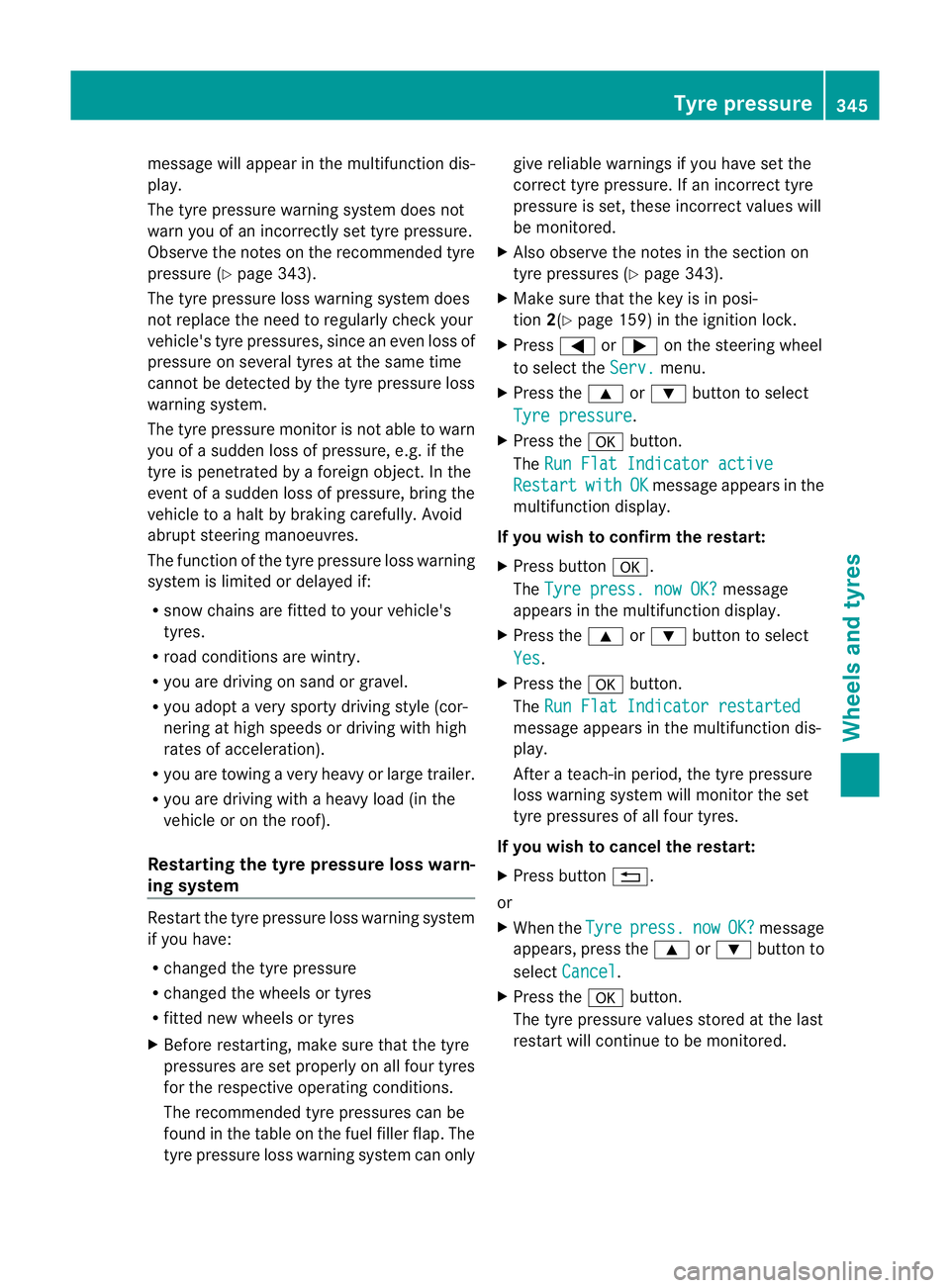
message will appear in the multifunction dis-
play.
The tyre pressure warning system does not
warn you of an incorrectly set tyre pressure.
Observe the notes on the recommended tyre
pressure (Y page 343).
The tyre pressure loss warning system does
not replace the need to regularly check your
vehicle's tyre pressures, since an even loss of
pressure on several tyres at the same time
cannot be detected by the tyre pressure loss
warning system.
The tyre pressure monitor is not able to warn
you of a sudden loss of pressure, e.g. if the
tyre is penetrated by a foreign object. In the
event of a sudden loss of pressure, bring the
vehicle to a haltb y braking carefully. Avoid
abrupt steering manoeuvres.
The function of the tyre pressure loss warning
system is limited or delaye dif:
R snow chains are fitted to you rvehicle's
tyres.
R road conditions are wintry.
R you are driving on sand or gravel.
R you adopt a very sporty driving style (cor-
nering at high speeds or driving with high
rates of acceleration).
R you are towing a very heavy or large trailer.
R you are driving with a heavy load (in the
vehicle or on the roof).
Restarting the tyre pressure loss warn-
ing system Restart the tyre pressure loss warning system
if you have:
R changed the tyre pressure
R changed the wheels or tyres
R fitted new wheels or tyres
X Before restarting, make sure that the tyre
pressures are set properly on all four tyres
for the respective operating conditions.
The recommended tyre pressures can be
found in the table on the fuel filler flap. The
tyre pressure loss warning system can only give reliable warnings if you have set the
correct tyre pressure. If an incorrect tyre
pressure is set, these incorrect values will
be monitored.
X Also observe the notes in the section on
tyre pressures (Y page 343).
X Make sure that the key is in posi-
tion 2(Ypage 159) in the ignition lock.
X Press =or; on the steering wheel
to select the Serv. menu.
X Press the 9or: button to select
Tyre pressure .
X Press the abutton.
The Run Flat Indicator active Restart with OK message appears in the
multifunction display.
If you wish to confirm the restart:
X Press button a.
The Tyre press. now OK? message
appears in the multifunction display.
X Press the 9or: button to select
Yes .
X Press the abutton.
The Run Flat Indicator restarted message appears in the multifunction dis-
play.
After a teach-in period, the tyre pressure
loss warning system will monitor the set
tyre pressures of all four tyres.
If you wish to cancel the restart:
X Press button %.
or
X When the Tyre press. now OK? message
appears, press the 9or: button to
select Cancel .
X Press the abutton.
The tyre pressure values stored at the last
restart will continue to be monitored. Tyre pressure
345Wheels and tyres Z
Page 349 of 389
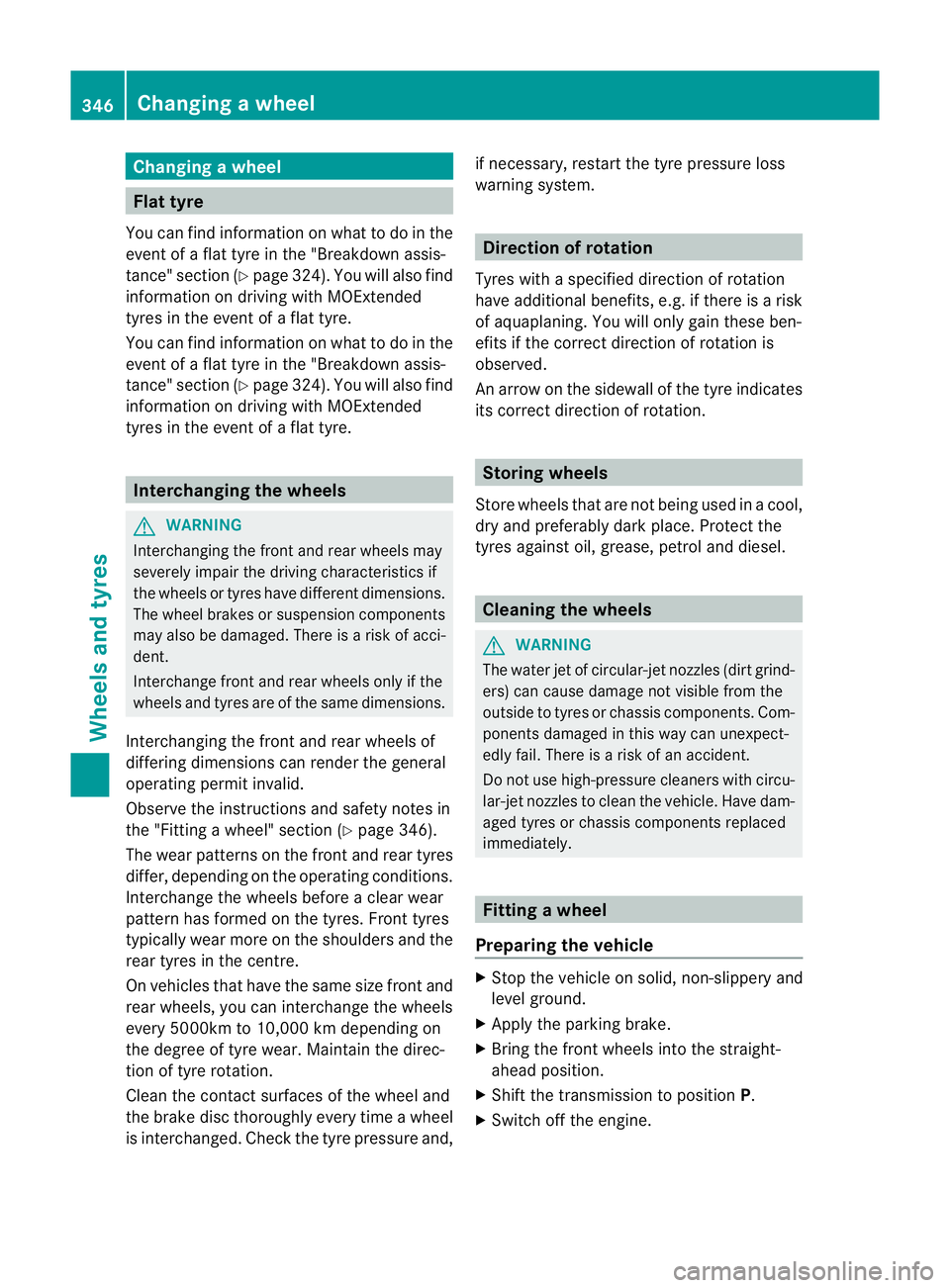
Changing
awheel Flat tyre
You can find information on wha tto do in the
event of a flat tyre in the "Breakdown assis-
tance" section (Y page 324). You will also find
information on driving with MOExtended
tyres in the event of a flat tyre.
You can find information on what to do in the
event of a flat tyre in the "Breakdown assis-
tance" section (Y page 324). You will also find
information on driving with MOExtended
tyres in the event of a flat tyre. Interchanging the wheels
G
WARNING
Interchanging the front and rear wheels may
severely impair the driving characteristics if
the wheels or tyres have different dimensions.
The wheel brakes or suspension components
may also be damaged. There is a risk of acci-
dent.
Interchange front and rear wheels only if the
wheels and tyres are of the same dimensions.
Interchanging the front and rear wheels of
differing dimensions can render the general
operating permit invalid.
Observe the instructions and safety notes in
the "Fitting a wheel" section (Y page 346).
The wear patterns on the front and rear tyres
differ, depending on the operating conditions.
Interchange the wheels before a clear wear
pattern has formed on the tyres. Front tyres
typically wear more on the shoulders and the
rear tyres in the centre.
On vehicles that have the same size front and
rear wheels, you can interchange the wheels
every 5000km to 10,000 km depending on
the degree of tyre wear. Maintain the direc-
tion of tyre rotation.
Clean the contact surfaces of the wheel and
the brake disc thoroughly every time a wheel
is interchanged. Check the tyre pressure and, if necessary, restart the tyre pressure loss
warning system. Direction of rotation
Tyres with a specified direction of rotation
have additional benefits, e.g. if there is a risk
of aquaplaning. You will only gain these ben-
efits if the correct direction of rotation is
observed.
An arrow on the sidewall of the tyre indicates
its correct direction of rotation. Storing wheels
Store wheels that are not being used in a cool,
dry and preferably dark place. Protec tthe
tyres against oil, grease, petrol and diesel. Cleaning the wheels
G
WARNING
The water jet of circular-jet nozzles (dirt grind-
ers) can cause damage not visible from the
outside to tyres or chassis components. Com-
ponents damaged in this way can unexpect-
edly fail. There is a risk of an accident.
Do not use high-pressure cleaners with circu-
lar-jet nozzles to clean the vehicle. Have dam-
aged tyres or chassis components replaced
immediately. Fitting
awheel
Preparing the vehicle X
Stop the vehicle on solid, non-slippery and
level ground.
X Apply the parking brake.
X Bring the front wheels into the straight-
ahead position.
X Shift the transmission to position P.
X Switch off the engine. 346
Changing
awheelWheels and tyres
Page 353 of 389
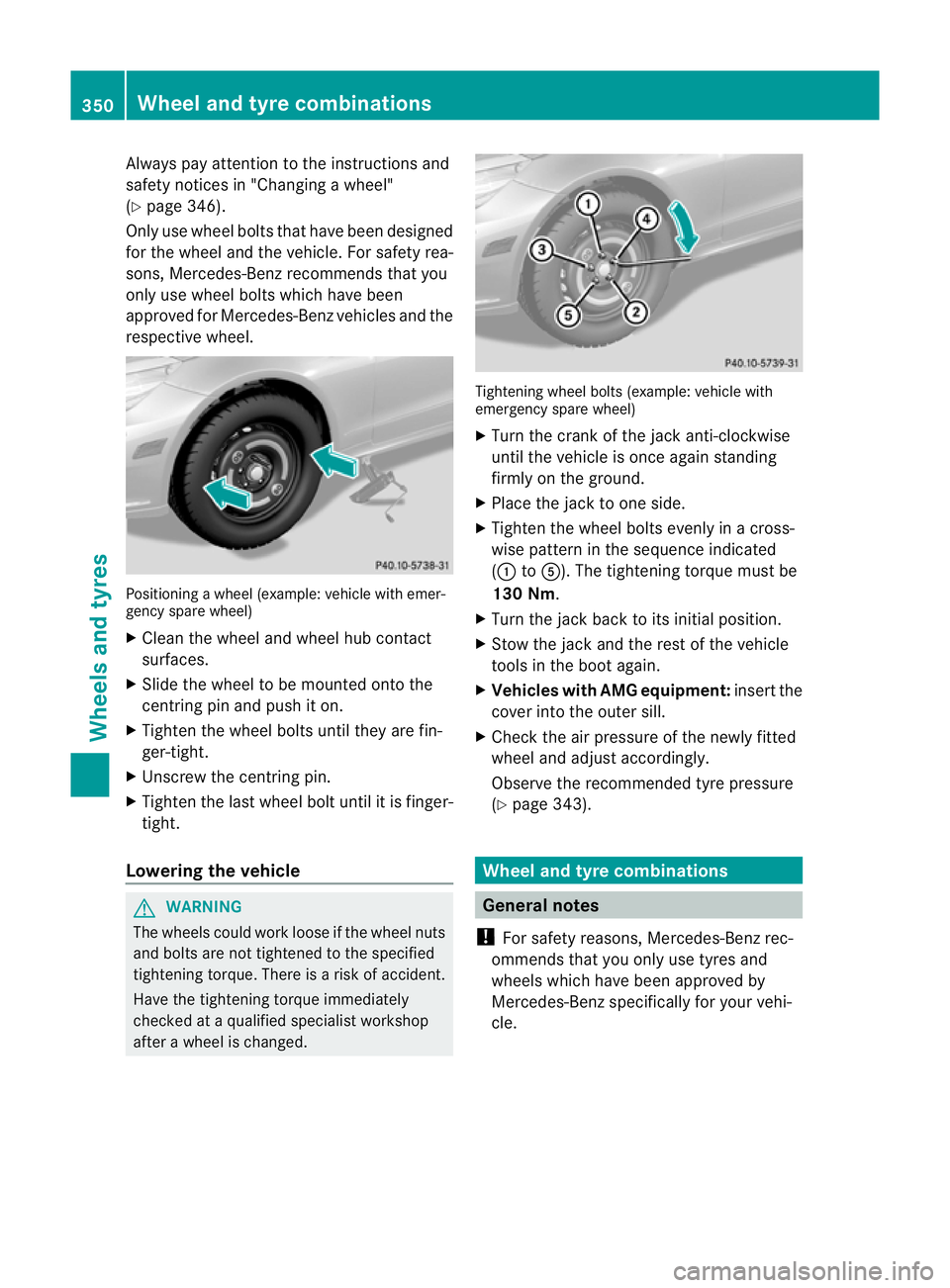
Always pay attentio
nto the instructions and
safety notices in "Changing a wheel"
(Y page 346).
Only use wheel bolts that have been designed
for the wheel and the vehicle. For safety rea-
sons, Mercedes-Benz recommends that you
only use wheel bolts which have been
approved for Mercedes-Benz vehicles and the
respective wheel. Positioning a wheel (example: vehicle with emer-
gency spare wheel)
X Clean the wheel and wheel hub contact
surfaces.
X Slide the wheel to be mounted onto the
centring pin and push it on.
X Tighten the wheel bolts until they are fin-
ger-tight.
X Unscrew the centring pin.
X Tighten the last wheel bolt until it is finger-
tight.
Lowering the vehicle G
WARNING
The wheels could work loose if the wheel nuts
and bolts are not tightened to the specified
tightening torque. There is a risk of accident.
Have the tightening torque immediately
checked at a qualified specialist workshop
after a wheel is changed. Tightening wheel bolts (example: vehicle with
emergency spare wheel)
X Turn the crank of the jack anti-clockwise
until the vehicle is once again standing
firmly on the ground.
X Place the jack to one side.
X Tighten the wheel bolts evenly in a cross-
wise pattern in the sequence indicated
(: toA). The tightening torque must be
130 Nm.
X Turn the jack back to its initial position.
X Stow the jack and the rest of the vehicle
tools in the boot again.
X Vehicles with AMG equipment: insert the
cover into the outer sill.
X Check the air pressure of the newly fitted
wheel and adjust accordingly.
Observe the recommended tyre pressure
(Y page 343). Wheel and tyre combinations
General notes
! For safety reasons, Mercedes-Benz rec-
ommends that you only use tyres and
wheels which have been approved by
Mercedes-Benz specifically for your vehi-
cle. 350
Wheel and tyre combinationsWheels and tyres
Page 354 of 389
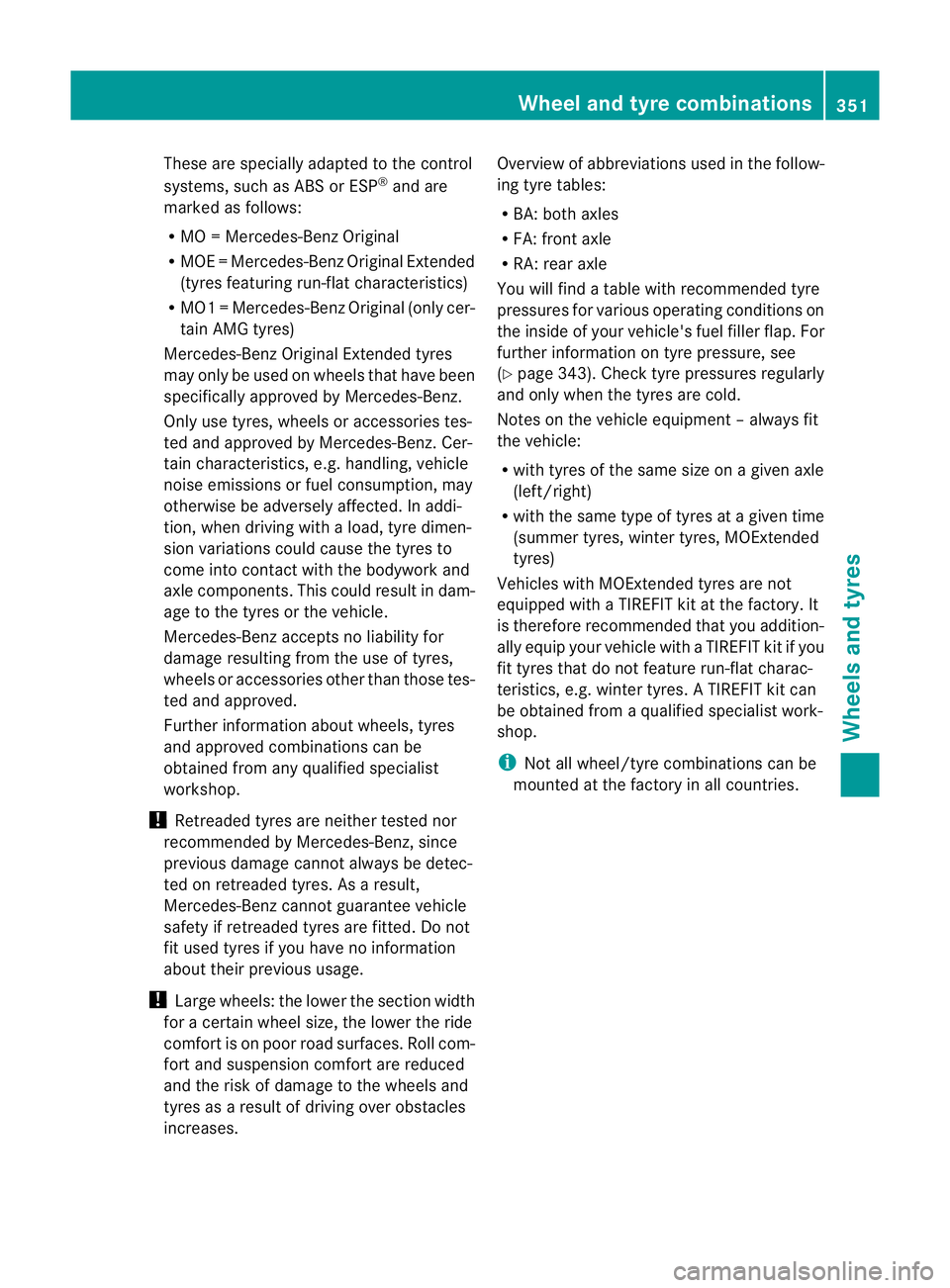
These are specially adapted to the control
systems, such as ABS or ESP ®
and are
marked as follows:
R MO =Mercedes-Benz Original
R MOE =Mercedes-BenzO riginal Extended
(tyres featuring run-flat characteristics)
R MO1 =Mercedes-Benz Original (only cer-
tain AMG tyres)
Mercedes-BenzO riginal Extended tyres
may only be used on wheels that have been
specifically approved by Mercedes-Benz.
Only use tyres, wheels or accessories tes-
ted and approved by Mercedes-Benz. Cer-
tain characteristics, e.g. handling, vehicle
noise emissions or fuel consumption, may
otherwise be adversely affected. In addi-
tion, when driving with aload, tyre dimen-
sion variations could cause the tyres to
come into contact with the bodywork and
axle components.T his could result in dam-
age to the tyres or the vehicle.
Mercedes-Ben zaccepts no liability for
damage resulting from the use of tyres,
wheels or accessories othe rthan those tes-
ted and approved.
Further information about wheels, tyres
and approved combinations can be
obtained from any qualified specialist
workshop.
! Retreaded tyres are neither tested nor
recommended by Mercedes-Benz, since
previous damage cannot always be detec-
ted on retreaded tyres. As a result,
Mercedes-Ben zcannot guarantee vehicle
safety if retreaded tyres are fitted. Do not
fit used tyres if you have no information
about their previous usage.
! Large wheels :the lower the section width
for a certain wheel size, the lower the ride
comfort is on poor road surfaces. Roll com-
fort and suspension comfort are reduced
and the risk of damage to the wheels and
tyres as a result of driving over obstacles
increases. Overview of abbreviations used in the follow-
ing tyre tables:
R
BA: both axles
R FA: front axle
R RA: rear axle
You will find a table with recommended tyre
pressures for various operating conditions on
the inside of your vehicle's fuel filler flap. For
further information on tyre pressure, see
(Y page 343). Check tyre pressures regularly
and only when the tyres are cold.
Notes on the vehicle equipment –always fit
the vehicle:
R with tyres of the same size on a given axle
(left/right)
R with the same type of tyres at a given time
(summer tyres, winter tyres, MOExtended
tyres)
Vehicles with MOExtended tyres are not
equipped with a TIREFIT kit at the factory. It
is therefore recommended that you addition-
ally equip your vehicle with a TIREFIT kit if you
fit tyres that do not feature run-flat charac-
teristics, e.g. winter tyres. A TIREFIT kit can
be obtained fro maqualified specialist work-
shop.
i Not all wheel/tyre combinations can be
mounted at the factory in all countries. Wheel and tyre combinations
351Wheels and tyres Z
Page 355 of 389
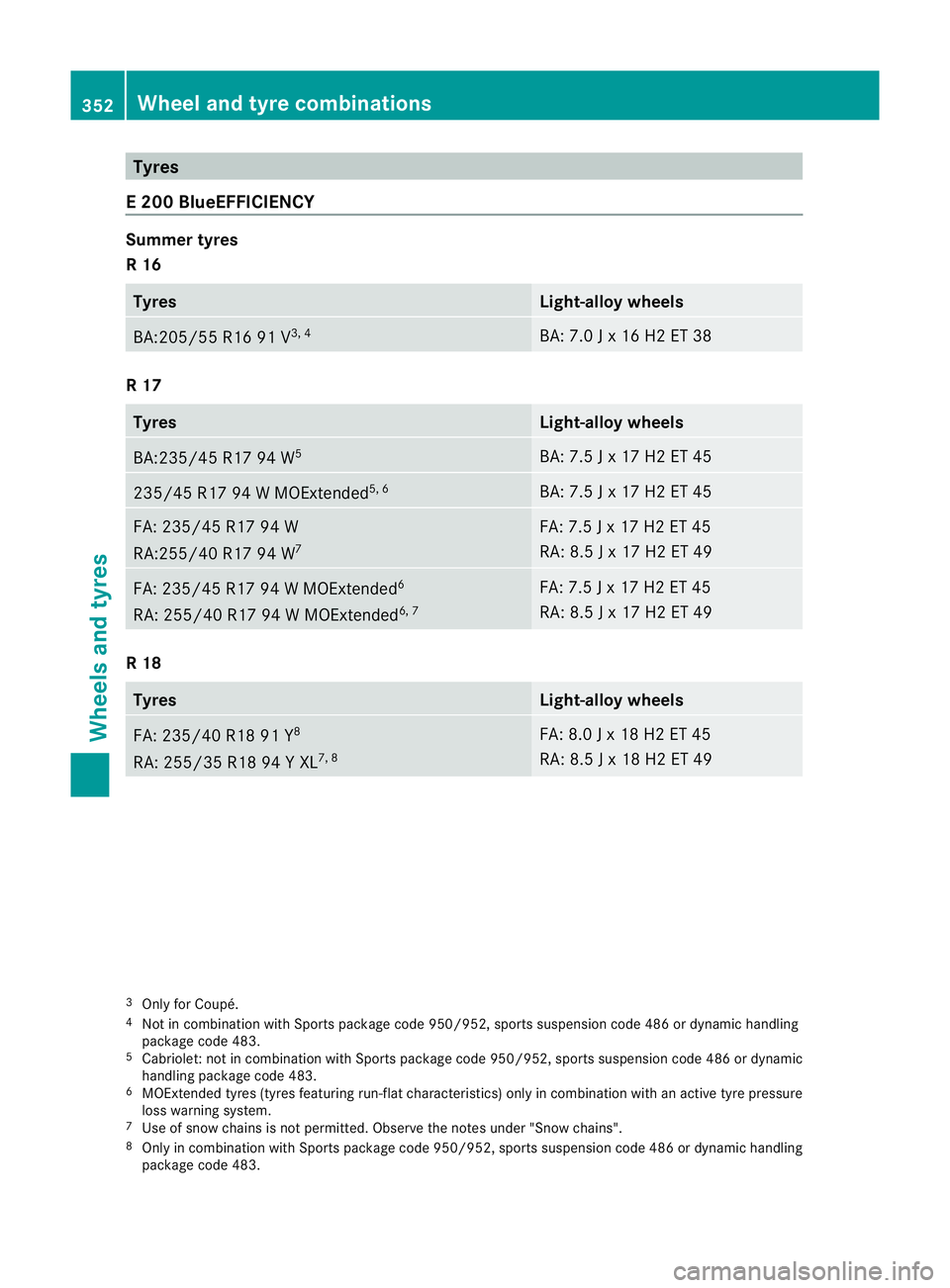
Tyres
E 200 BlueEFFICIENCY Summer tyres
R 16 Tyres Light-alloy wheels
BA:205/5
5 R16 91 V 3, 4 BA: 7.0 J x 16 H2 ET 38
R 17
Tyres Light-allo
ywheels BA:235/45 R17 94 W
5 BA: 7.5 J x 17 H2 ET 45
235/45 R17 94 W MOExtended
5, 6 BA: 7.5 J x 17 H2 ET 45
FA: 235/45 R17 94 W
RA:255/40 R17 94 W
7 FA: 7.5 J x 17 H2 ET 45
RA: 8.5 J x 17 H2 ET 49
FA: 235/45 R17 94 W MOExtended
6
RA: 255/40 R17 94 W MOExtended 6, 7 FA: 7.5 J x 17 H2 ET 45
RA: 8.5 J x 17 H2 ET 49
R 18
Tyres Light-alloy wheels
FA: 235/40 R18 91 Y
8
RA: 255/35 R18 94 Y XL 7, 8 FA: 8.0 J x 18 H2 ET 45
RA: 8.5 J x 18 H2 ET 49
3
Only for Coupé.
4 Not in combination with Sports package code 950/952, sports suspension code 486 or dynamic handling
package code 483.
5 Cabriolet: not in combination with Sports package code 950/952, sports suspension code 486 or dynamic
handling package code 483.
6 MOExtended tyres (tyres featuring run-fla tcharacteristics) only in combination with an active tyre pressure
loss warning system.
7 Use of snow chains is not permitted. Observe the notes under "Snow chains".
8 Only in combination with Sports package code 950/952, sports suspension code 486 or dynamic handling
package code 483. 352
Wheel and tyre combinationsWheels and tyres
Page 356 of 389
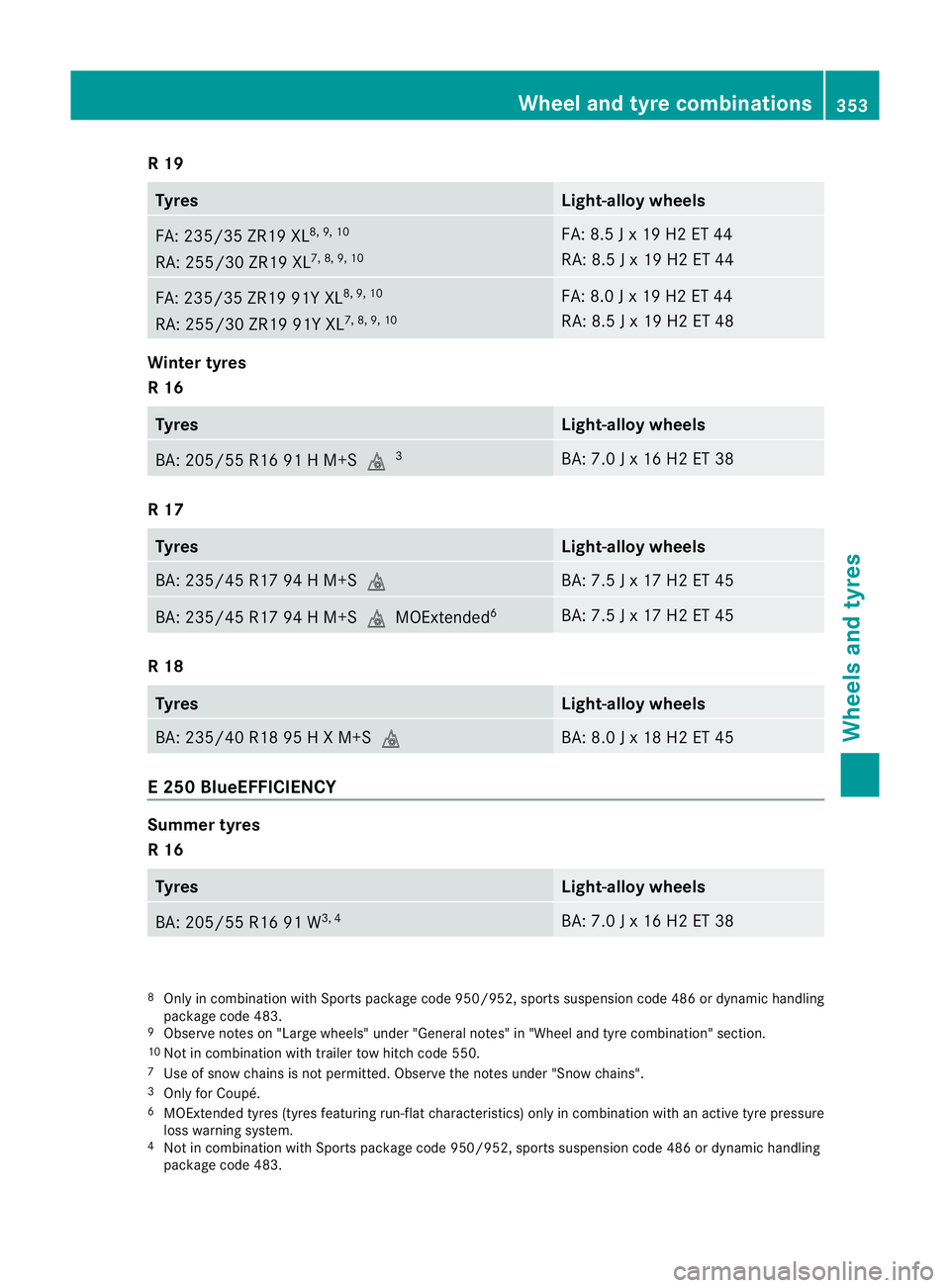
R 19
Tyres Light-allo
ywheels FA: 235/35 ZR19 XL
8, 9, 10
RA: 255/30 ZR19 XL 7, 8, 9, 10 FA: 8.5 J x 19 H2 ET 44
RA: 8.5 J x 19 H2 ET 44
FA: 235/35 ZR19 91Y XL
8, 9, 10
RA: 255/30 ZR19 91Y XL 7, 8, 9, 10 FA: 8.0 J x 19 H2 ET 44
RA: 8.5 J x 19 H2 ET 48
Winter tyres
R 16
Tyres Light-alloy wheels
BA: 205/55 R16 91 H M+S
i3 BA: 7.0 J x 16 H2 ET 38
R 17
Tyres Light-alloy wheels
BA: 235/45 R17 94 H M+S
i BA: 7.5 J x 17 H2 ET 45
BA: 235/45 R17 94 H M+S
iMOExtended6 BA: 7.5 J x 17 H2 ET 45
R 18
Tyres Light-alloy wheels
BA: 235/40 R18 95 H X M+S
i BA: 8.0 J x 18 H2 ET 45
E 250 BlueEFFICIENCY
Summer tyres
R 16
Tyres Light-alloy wheels
BA: 205/55 R16 91 W
3, 4 BA: 7.0 J x 16 H2 ET 38
8
Only in combination with Sports package code 950/952, sports suspension code 486 or dynamic handling
package code 483.
9 Observe notes on "Large wheels" under "General notes" in "Wheel and tyre combination" section.
10 Not in combination with trailer tow hitch code 550.
7 Use of snow chains is not permitted. Observe the notes under "Snow chains".
3 Only for Coupé.
6 MOExtended tyres (tyres featuring run-fla tcharacteristics) only in combination with an active tyre pressure
loss warning system.
4 Not in combination with Sports package code 950/952, sports suspension code 486 or dynamic handling
package code 483. Wheel and tyre combinations
353Wheels and tyres Z
Page 357 of 389
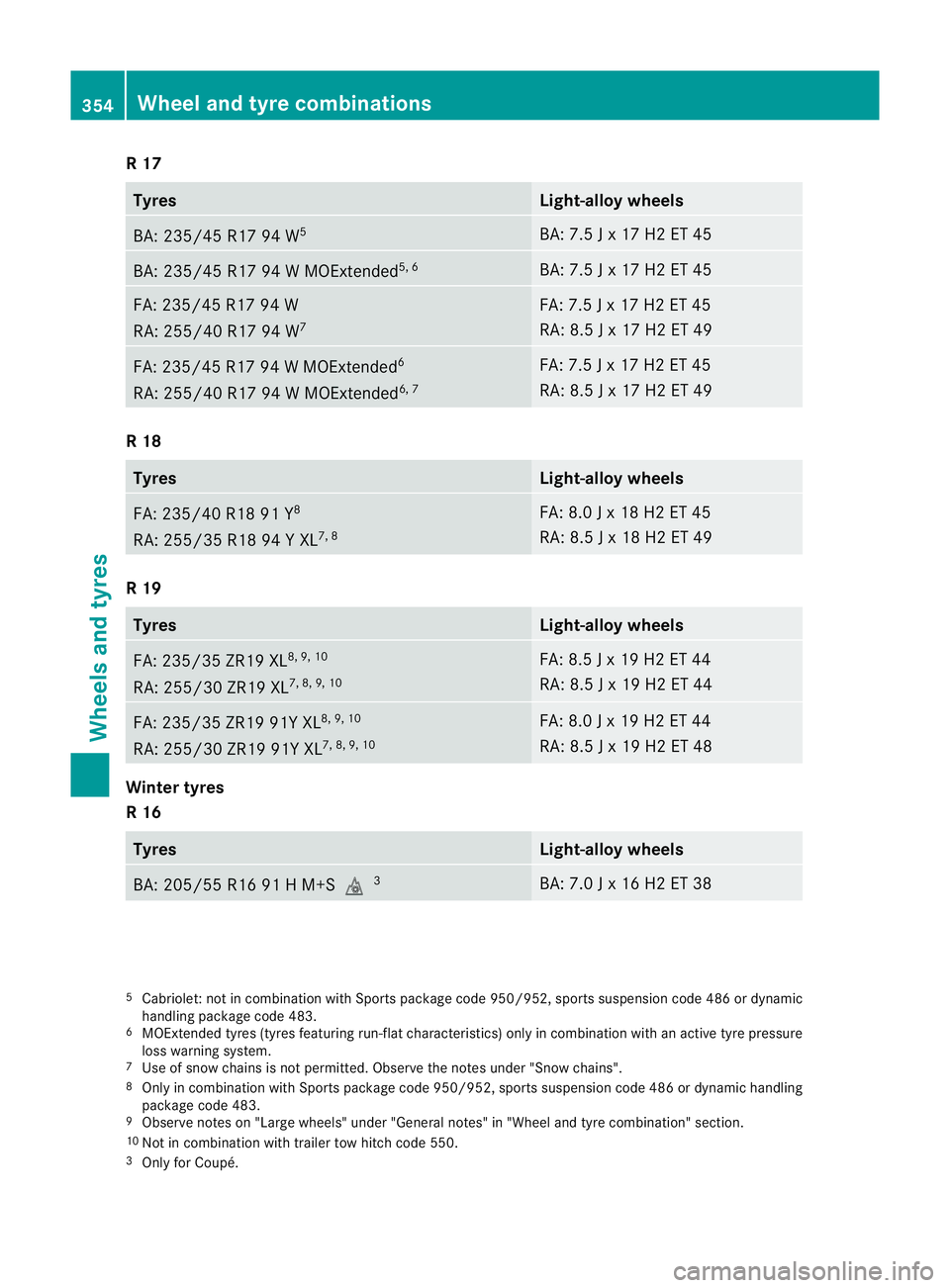
R 17
Tyres Light-allo
ywheels BA: 235/45 R17 94 W
5 BA: 7.5 J x 17 H2 ET 45
BA: 235/45 R17 94 W MOExtended
5, 6 BA: 7.5 J x 17 H2 ET 45
FA: 235/45 R17 94 W
RA: 255/40 R17 94 W
7 FA: 7.5 J x 17 H2 ET 45
RA: 8.5 J x 17 H2 ET 49
FA: 235/45 R17 94 W MOExtended
6
RA: 255/40 R17 94 W MOExtended 6, 7 FA: 7.5 J x 17 H2 ET 45
RA: 8.5 J x 17 H2 ET 49
R 18
Tyres Light-alloy wheels
FA: 235/40 R18 91 Y
8
RA: 255/35 R18 94 Y XL 7, 8 FA: 8.0 J x 18 H2 ET 45
RA: 8.5 J x 18 H2 ET 49
R 19
Tyres Light-alloy wheels
FA: 235/35 ZR19 XL
8, 9, 10
RA: 255/30 ZR19 XL 7, 8, 9, 10 FA: 8.5 J x 19 H2 ET 44
RA: 8.5 J x 19 H2 ET 44
FA: 235/35 ZR19 91Y XL
8, 9, 10
RA: 255/30 ZR19 91Y XL 7, 8, 9, 10 FA: 8.0 J x 19 H2 ET 44
RA: 8.5 J x 19 H2 ET 48
Winter tyres
R 16
Tyres Light-alloy wheels
BA: 205/55 R16 91 H M+S
i3 BA: 7.0 J x 16 H2 ET 38
5
Cabriolet: not in combination with Sports package code 950/952, sports suspension code 486 or dynamic
handling package code 483.
6 MOExtended tyres (tyres featuring run-fla tcharacteristics) only in combination with an active tyre pressure
loss warning system.
7 Use of snow chains is not permitted. Observe the notes under "Snow chains".
8 Only in combination with Sports package code 950/952, sports suspension code 486 or dynamic handling
package code 483.
9 Observe notes on "Large wheels" under "General notes" in "Wheel and tyre combination" section.
10 Not in combination with trailer tow hitch code 550.
3 Only for Coupé. 354
Wheel and tyre combinationsWheels and tyres